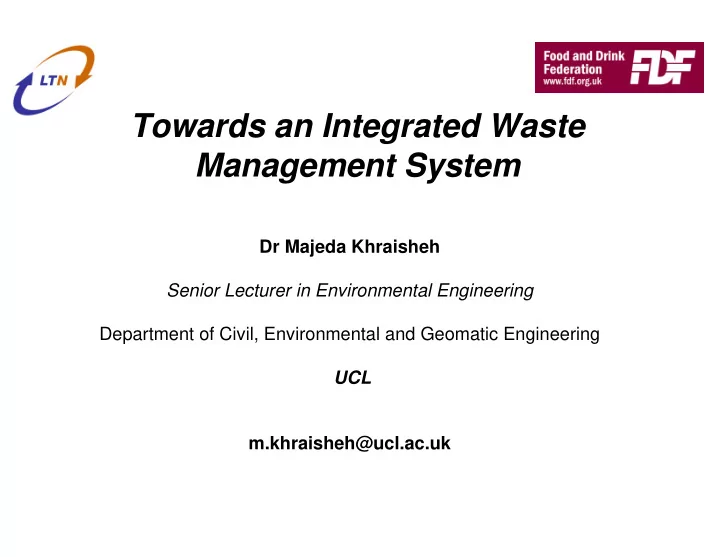

Towards an Integrated Waste Management System Dr Majeda Khraisheh Senior Lecturer in Environmental Engineering Department of Civil, Environmental and Geomatic Engineering UCL m.khraisheh@ucl.ac.uk
Background • 434 million tonnes of waste produced each year in the UK 1 • >70% of waste to Landfill sites 2 • Problems with landfill – unsustainable, pollution • Landfill tax and Government campaigns There must be an increase in the use of alternative waste management technologies 1 Waste online, 2004 2 Environmental Agency, 2008
Waste Management Technology (MSW/food waste) • Existing Technology � Landfill REDUCTION � Animal Feed RECOVER � Recycling RECYCLING � Composting � Incineration COMPOSTING • Current status: INCINERATION • New technologies DISPOSAL • Waste to energy • Waste to bioFuel The Waste Hierarchy 1 1 DETR 2001
MSW-to-bioethanol MSW Stream consists of three main fractions: 1) Dry recyclables, 2) Biodegradable waste, 3) Residual waste BMSW Residual Fractions consists of 3 main fractions: 1) Paper & Card, 2) Food Organics, 3) Green Organics BMSW Fraction Materials Paper & Card consists of many individual and composite materials . An understanding of MSW at four different scales is required in order to Material Biomass understand Paper is made from softwoods and its availability and quality as hardwoods which have different a feedstock biochemical properties .
Materials for Re- Dry recyclables Manufacture Existing Incineration Landfill or low-value uses Residual waste Raw materials for MSW Pyrolysis & Gasification industrial use • Sugar/starch Biomass • Lignocellulosic Biomass Mechanical biological treatment Materials for Anaerobic digestion horticulture and agriculture Composting SNG Biodegradable Waste • Sugar/starch Biomass Gasification Hydrogen • Lignocellulosic Biomass Methanol DME Hydrothernal Biomass source FT Diesel liquifaction Biomass feedstock Flash pyrolysis Biodiesel Conversion process End-product biofuels Hydrolysis & Bioethanol End-product materials Fermentation
Waste-to-Bioethanol • Assess the potential of waste-to-bioethanol system as an alternative waste management solution. • Assess the system specification and technical performance requirement if this waste-to-bioethanol process is to be applied • For a bio-ethanol conversion facility to be successful is to require an available low-cost feedstock which has a reliable high-quality. • Assess the potential for MSW in meeting these requirements. • An understanding of MSW at different scales is required in order to understand its availability, quality and reliability as a bioethanol feedstock. • It is important that the feedstock is available on a continuous basis and of sufficient quantity for a bioethanol facility to be economically feasible. • Consider the resource availability of MSW for a facility located within London.
The reliability of the feedstock • Defined as the consistency with which it meets certain quality requirements (or tolerances). • The quality of a feedstock can be measured by its maximum theoretical ethanol yield and the efficiency of the conversion process. • The maximum theoretical yield is dependent on the proportion of key structural components of the biomass (mainly cellulose and hemicellulose). • The efficiency and performance of the conversion process is influenced by a variety of physical and chemical feedstock properties. The level of influence these have depends on the sensitivity of chosen technology.
An overview of the main routes for biofuel production Energy Crops: Pressing or Biodiesel Agricultural & Oil plants extraction (alky esters) Forestry RVO / animal fat Bio Oil Wastes: Agricultural, Sugar/starch Hydrolysis Fermentation Municipal, Bioethanol Biomass Commercial, & Industrial Residues: Lignocellulosic Anaerobic Agricultural & SNG Biomass digestion Forestry Gasification Methanol Biomass source DME Biomass feedstock Hydrothernal FT Diesel liquifaction Production technologies Flash pyrolysis Biodiesel Biofuel end-product
London BMSW London Waste Streams Waste Fraction England London Civic Household Other waste Proportion of 2003/04 All Recycling amenity waste streams MSW steam MSW sites PC 18.1 23.6 27.8 36.0 2.0 24-38 KO 26.5 g 12.4 g 17.2 26.1 0.0 16-22 GO 7.8 g 4.2 g 19.2 7.7 8.0 2-16 BMSW 54.5 57.4 62.1 52.0 10.0 -
Predicted availability of BMSW trends for new recovery technologies 2000 1800 1600 1400 1200 GO 1000 KO PC 800 600 400 200 0 2003/04 2010 2015 2020
Municipal Solid Multi or single stream Society Waste Dry Recyclables materials recovery Materials for Re- Manufacture Biochemical Treatment Source BMSW Hydrolysis & Segregated: Bioethanol Fermentation PCW Household recycling, non IN-vessel Materials for household KOW Composting horticulture and recycling agriculture Anaerobic GOW digestion SNG Windrow Composting Mixed waste Process Low-value uses processing Residues & Rejects Landfill Heat & Power Thermochemical Treatment Residual: Hydrogen, Regular Household Methanol, Incineration with Collection, Civic Methanol, EfW Amenity sites, DME, other household FT Diesel sources, non house Gasification / hold sources excl. Pyrolysis Raw materials recycling for industrial use MSW Process Hydrothernal source liquefaction or Biodiesel MSW Primary end- Flash pyrolysis feedstock products
Summary • London’s waste contains a high proportion of biodegradable material. • Currently a high proportion of this waste is sent to landfill. • London’s Waste Management Strategy sets ambitious targets for diverting this waste to management options further up the hierarchy
Summary • Based on this rough compositional data and projecting forward the Mayor’s ‘preferred’ strategy under a number of assumptions the quantity of biodegradable waste available for new recovery processes can be estimated. • Approximately 1.6 million tonnes of BMSW could be available for bioethanol production if it was the only new recovery processes established. • The majority of this waste is Kitchen Organic
Summary • For bioethanol production to be successful it will requires integration with a well developed waste management system. • Increased source segregation and utilisation of materials on the basis of Best Practicable Environmental Option will be critical in establishing a viable market share of the waste resources as the number of competing waste management options increases.
Recommend
More recommend